[English] 日本語
 Yorodumi
Yorodumi- EMDB-45213: AP-3 bound to myristoylated Arf1 (Q71L) and LAMPI on a lipid nano... -
+ Open data
Open data
- Basic information
Basic information
| Entry |  | |||||||||
|---|---|---|---|---|---|---|---|---|---|---|
| Title | AP-3 bound to myristoylated Arf1 (Q71L) and LAMPI on a lipid nanodisc; combined map | |||||||||
 Map data Map data | deepEMhancer sharpened map | |||||||||
 Sample Sample |
| |||||||||
 Keywords Keywords | Adaptor Protein complex / AP-3 / Lysosomal transport / Endosomal transport / Protein trafficking / TRANSPORT PROTEIN | |||||||||
| Function / homology |  Function and homology information Function and homology informationsynaptic vesicle coating / synaptic vesicle budding from endosome / : / clathrin-coated vesicle cargo loading, AP-3-mediated / skin epidermis development / AP-type membrane coat adaptor complex / synaptic vesicle membrane organization / regulation of organelle transport along microtubule / zinc ion import into lysosome / AP-3 adaptor complex ...synaptic vesicle coating / synaptic vesicle budding from endosome / : / clathrin-coated vesicle cargo loading, AP-3-mediated / skin epidermis development / AP-type membrane coat adaptor complex / synaptic vesicle membrane organization / regulation of organelle transport along microtubule / zinc ion import into lysosome / AP-3 adaptor complex / positive regulation of natural killer cell degranulation / neurotransmitter receptor transport, postsynaptic endosome to lysosome / anterograde synaptic vesicle transport / granzyme-mediated programmed cell death signaling pathway / phagolysosome membrane / microvesicle / Golgi to lysosome transport / endosome to melanosome transport / mitotic cleavage furrow ingression / establishment of protein localization to organelle / cytolytic granule membrane / trans-Golgi Network Vesicle Budding / synaptic vesicle recycling / postsynaptic recycling endosome / Golgi to vacuole transport / clathrin adaptor complex / platelet dense granule organization / Glycosphingolipid transport / melanosome assembly / regulation of receptor internalization / Intra-Golgi traffic / presynaptic endosome / regulation of Arp2/3 complex-mediated actin nucleation / postsynaptic neurotransmitter receptor internalization / granulocyte differentiation / positive regulation of NK T cell differentiation / Synthesis of PIPs at the Golgi membrane / clathrin-coated vesicle membrane / lysosomal lumen acidification / positive regulation of natural killer cell mediated cytotoxicity / antigen processing and presentation, exogenous lipid antigen via MHC class Ib / protein targeting to vacuole / GTP-dependent protein binding / melanosome organization / protein targeting to lysosome / respiratory system process / anterograde axonal transport / Nef Mediated CD4 Down-regulation / intracellular zinc ion homeostasis / dendritic spine organization / protein localization to cell surface / protein localization to membrane / long-term synaptic depression / COPI-dependent Golgi-to-ER retrograde traffic / lysosome organization / azurophil granule membrane / toll-like receptor signaling pathway / Lysosome Vesicle Biogenesis / Golgi Associated Vesicle Biogenesis / ion channel inhibitor activity / Association of TriC/CCT with target proteins during biosynthesis / Synthesis of PIPs at the plasma membrane / cell leading edge / lung morphogenesis / autolysosome / autophagosome membrane / homeostasis of number of cells / ficolin-1-rich granule membrane / intracellular copper ion homeostasis / intracellular transport / single fertilization / hematopoietic progenitor cell differentiation / transport vesicle / COPI-mediated anterograde transport / vesicle-mediated transport / multivesicular body / axon cytoplasm / MHC class II antigen presentation / Gene and protein expression by JAK-STAT signaling after Interleukin-12 stimulation / cytoplasmic vesicle membrane / sarcomere / small monomeric GTPase / intracellular protein transport / mRNA transcription by RNA polymerase II / sarcolemma / cellular response to virus / protein modification process / small GTPase binding / endocytosis / cell morphogenesis / terminal bouton / blood coagulation / synaptic vesicle / Signaling by BRAF and RAF1 fusions / late endosome membrane / insulin receptor signaling pathway / melanosome / late endosome / presynapse / virus receptor activity Similarity search - Function | |||||||||
| Biological species |  Homo sapiens (human) Homo sapiens (human) | |||||||||
| Method | single particle reconstruction / cryo EM / Resolution: 4.5 Å | |||||||||
 Authors Authors | Begley MC / Baker RW | |||||||||
| Funding support |  United States, 1 items United States, 1 items
| |||||||||
 Citation Citation |  Journal: Proc Natl Acad Sci U S A / Year: 2024 Journal: Proc Natl Acad Sci U S A / Year: 2024Title: A structure-based mechanism for initiation of AP-3 coated vesicle formation. Authors: Matthew Begley / Mahira Aragon / Richard W Baker /  Abstract: Adaptor protein complex-3 (AP-3) mediates cargo sorting from endosomes to lysosomes and lysosome-related organelles. Recently, it was shown that AP-3 adopts a constitutively open conformation ...Adaptor protein complex-3 (AP-3) mediates cargo sorting from endosomes to lysosomes and lysosome-related organelles. Recently, it was shown that AP-3 adopts a constitutively open conformation compared to the related AP-1 and AP-2 coat complexes, which are inactive until undergoing large conformational changes upon membrane recruitment. How AP-3 is regulated is therefore an open question. To understand the mechanism of AP-3 membrane recruitment and activation, we reconstituted human AP-3 and determined multiple structures in the soluble and membrane-bound states using electron cryo-microscopy. Similar to yeast AP-3, human AP-3 is in a constitutively open conformation. To reconstitute AP-3 activation by adenosine di-phosphate (ADP)-ribosylation factor 1 (Arf1), a small guanosine tri-phosphate (GTP)ase, we used lipid nanodiscs to build Arf1-AP-3 complexes on membranes and determined three structures showing the stepwise conformational changes required for formation of AP-3 coated vesicles. First, membrane recruitment is driven by one of two predicted Arf1 binding sites, which flexibly tethers AP-3 to the membrane. Second, cargo binding causes AP-3 to adopt a fixed position and rigidifies the complex, which stabilizes binding for a second Arf1 molecule. Finally, binding of the second Arf1 molecule provides the template for AP-3 dimerization, providing a glimpse into the first step of coat polymerization. We propose coat polymerization only occurs after cargo engagement, thereby linking cargo sorting with assembly of higher-order coat structures. Additionally, we provide evidence for two amphipathic helices in AP-3, suggesting that AP-3 contributes to membrane deformation during coat assembly. In total, these data provide evidence for the first stages of AP-3-mediated vesicle coat assembly. | |||||||||
| History |
|
- Structure visualization
Structure visualization
| Supplemental images |
|---|
- Downloads & links
Downloads & links
-EMDB archive
| Map data |  emd_45213.map.gz emd_45213.map.gz | 214.8 MB |  EMDB map data format EMDB map data format | |
|---|---|---|---|---|
| Header (meta data) |  emd-45213-v30.xml emd-45213-v30.xml emd-45213.xml emd-45213.xml | 32.8 KB 32.8 KB | Display Display |  EMDB header EMDB header |
| Images |  emd_45213.png emd_45213.png | 103.7 KB | ||
| Filedesc metadata |  emd-45213.cif.gz emd-45213.cif.gz | 8.8 KB | ||
| Others |  emd_45213_additional_1.map.gz emd_45213_additional_1.map.gz emd_45213_half_map_1.map.gz emd_45213_half_map_1.map.gz emd_45213_half_map_2.map.gz emd_45213_half_map_2.map.gz | 217.5 MB 217.5 MB 217.5 MB | ||
| Archive directory |  http://ftp.pdbj.org/pub/emdb/structures/EMD-45213 http://ftp.pdbj.org/pub/emdb/structures/EMD-45213 ftp://ftp.pdbj.org/pub/emdb/structures/EMD-45213 ftp://ftp.pdbj.org/pub/emdb/structures/EMD-45213 | HTTPS FTP |
-Validation report
| Summary document |  emd_45213_validation.pdf.gz emd_45213_validation.pdf.gz | 739.1 KB | Display |  EMDB validaton report EMDB validaton report |
|---|---|---|---|---|
| Full document |  emd_45213_full_validation.pdf.gz emd_45213_full_validation.pdf.gz | 738.7 KB | Display | |
| Data in XML |  emd_45213_validation.xml.gz emd_45213_validation.xml.gz | 15.8 KB | Display | |
| Data in CIF |  emd_45213_validation.cif.gz emd_45213_validation.cif.gz | 19 KB | Display | |
| Arichive directory |  https://ftp.pdbj.org/pub/emdb/validation_reports/EMD-45213 https://ftp.pdbj.org/pub/emdb/validation_reports/EMD-45213 ftp://ftp.pdbj.org/pub/emdb/validation_reports/EMD-45213 ftp://ftp.pdbj.org/pub/emdb/validation_reports/EMD-45213 | HTTPS FTP |
-Related structure data
| Related structure data |  9c5bMC  9c58C  9c59C  9c5aC  9c5cC M: atomic model generated by this map C: citing same article ( |
|---|---|
| Similar structure data | Similarity search - Function & homology  F&H Search F&H Search |
- Links
Links
| EMDB pages |  EMDB (EBI/PDBe) / EMDB (EBI/PDBe) /  EMDataResource EMDataResource |
|---|---|
| Related items in Molecule of the Month |
- Map
Map
| File |  Download / File: emd_45213.map.gz / Format: CCP4 / Size: 244.1 MB / Type: IMAGE STORED AS FLOATING POINT NUMBER (4 BYTES) Download / File: emd_45213.map.gz / Format: CCP4 / Size: 244.1 MB / Type: IMAGE STORED AS FLOATING POINT NUMBER (4 BYTES) | ||||||||||||||||||||||||||||||||||||
|---|---|---|---|---|---|---|---|---|---|---|---|---|---|---|---|---|---|---|---|---|---|---|---|---|---|---|---|---|---|---|---|---|---|---|---|---|---|
| Annotation | deepEMhancer sharpened map | ||||||||||||||||||||||||||||||||||||
| Projections & slices | Image control
Images are generated by Spider. | ||||||||||||||||||||||||||||||||||||
| Voxel size | X=Y=Z: 1.058 Å | ||||||||||||||||||||||||||||||||||||
| Density |
| ||||||||||||||||||||||||||||||||||||
| Symmetry | Space group: 1 | ||||||||||||||||||||||||||||||||||||
| Details | EMDB XML:
|
-Supplemental data
-Additional map: Composite full map
| File | emd_45213_additional_1.map | ||||||||||||
|---|---|---|---|---|---|---|---|---|---|---|---|---|---|
| Annotation | Composite full map | ||||||||||||
| Projections & Slices |
| ||||||||||||
| Density Histograms |
-Half map: Composite half map 1
| File | emd_45213_half_map_1.map | ||||||||||||
|---|---|---|---|---|---|---|---|---|---|---|---|---|---|
| Annotation | Composite half map 1 | ||||||||||||
| Projections & Slices |
| ||||||||||||
| Density Histograms |
-Half map: Composite half map 2
| File | emd_45213_half_map_2.map | ||||||||||||
|---|---|---|---|---|---|---|---|---|---|---|---|---|---|
| Annotation | Composite half map 2 | ||||||||||||
| Projections & Slices |
| ||||||||||||
| Density Histograms |
- Sample components
Sample components
-Entire : AP-3 bound to myristoylated Arf1 (Q71L) and LAMPI on a lipid nano...
| Entire | Name: AP-3 bound to myristoylated Arf1 (Q71L) and LAMPI on a lipid nanodisc; combined map |
|---|---|
| Components |
|
-Supramolecule #1: AP-3 bound to myristoylated Arf1 (Q71L) and LAMPI on a lipid nano...
| Supramolecule | Name: AP-3 bound to myristoylated Arf1 (Q71L) and LAMPI on a lipid nanodisc; combined map type: complex / ID: 1 / Parent: 0 / Macromolecule list: #1-#6 |
|---|---|
| Molecular weight | Theoretical: 215 KDa |
-Macromolecule #1: ADP-ribosylation factor 1
| Macromolecule | Name: ADP-ribosylation factor 1 / type: protein_or_peptide / ID: 1 / Details: Q to L mutation at position 71 / Number of copies: 2 / Enantiomer: LEVO / EC number: small monomeric GTPase |
|---|---|
| Source (natural) | Organism:  Homo sapiens (human) Homo sapiens (human) |
| Molecular weight | Theoretical: 20.775812 KDa |
| Recombinant expression | Organism:  |
| Sequence | String: GNIFANLFKG LFGKKEMRIL MVGLDAAGKT TILYKLKLGE IVTTIPTIGF NVETVEYKNI SFTVWDVGGL DKIRPLWRHY FQNTQGLIF VVDSNDRERV NEAREELMRM LAEDELRDAV LLVFANKQDL PNAMNAAEIT DKLGLHSLRH RNWYIQATCA T SGDGLYEG LDWLSNQLRN QKSL UniProtKB: ADP-ribosylation factor 1 |
-Macromolecule #2: AP-3 complex subunit delta-1
| Macromolecule | Name: AP-3 complex subunit delta-1 / type: protein_or_peptide / ID: 2 / Number of copies: 1 / Enantiomer: LEVO |
|---|---|
| Source (natural) | Organism:  Homo sapiens (human) Homo sapiens (human) |
| Molecular weight | Theoretical: 69.381977 KDa |
| Recombinant expression | Organism:  |
| Sequence | String: MALKMVKGSI DRMFDKNLQD LVRGIRNHKE DEAKYISQCI DEIKQELKQD NIAVKANAVC KLTYLQMLGY DISWAAFNII EVMSASKFT FKRIGYLAAS QSFHEGTDVI MLTTNQIRKD LSSPSQYDTG VALTGLSCFV TPDLARDLAN DIMTLMSHTK P YIRKKAVL ...String: MALKMVKGSI DRMFDKNLQD LVRGIRNHKE DEAKYISQCI DEIKQELKQD NIAVKANAVC KLTYLQMLGY DISWAAFNII EVMSASKFT FKRIGYLAAS QSFHEGTDVI MLTTNQIRKD LSSPSQYDTG VALTGLSCFV TPDLARDLAN DIMTLMSHTK P YIRKKAVL IMYKVFLKYP ESLRPAFPRL KEKLEDPDPG VQSAAVNVIC ELARRNPKNY LSLAPLFFKL MTSSTNNWVL IK IIKLFGA LTPLEPRLGK KLIEPLTNLI HSTSAMSLLY ECVNTVIAVL ISLSSGMPNH SASIQLCVQK LRILIEDSDQ NLK YLGLLA MSKILKTHPK SVQSHKDLIL QCLDDKDESI RLRALDLLYG MVSKKNLMEI VKKLMTHVDK AEGTTYRDEL LTKI IDICS QSNYQYITNF EWYISILVEL TRLEGTRHGH LIAAQMLDVA IRVKAIRKFA VSQMSALLDS AHLLASSTQR NGICE VLYA AAWICGEFSE HLQEPHHTLE AMLRPRVTTL PGHIQAVYVQ NVVKLYASIL QQKEQAGEAE GAQAVTQLMV DRLPQF VQS ADLEVQERAS CILQLVKHIQ KLQAKDVPVA EEVSALFAGE LNPVAPKAQK KVPV UniProtKB: AP-3 complex subunit delta-1 |
-Macromolecule #3: AP-3 complex subunit mu-1
| Macromolecule | Name: AP-3 complex subunit mu-1 / type: protein_or_peptide / ID: 3 / Number of copies: 1 / Enantiomer: LEVO |
|---|---|
| Source (natural) | Organism:  Homo sapiens (human) Homo sapiens (human) |
| Molecular weight | Theoretical: 46.989965 KDa |
| Recombinant expression | Organism:  |
| Sequence | String: MIHSLFLINC SGDIFLEKHW KSVVSQSVCD YFFEAQEKAA DVENVPPVIS TPHHYLISIY RDKLFFVSVI QTEVPPLFVI EFLHRVADT FQDYFGECSE AAIKDNVVIV YELLEEMLDN GFPLATESNI LKELIKPPTI LRSVVNSITG SSNVGDTLPT G QLSNIPWR ...String: MIHSLFLINC SGDIFLEKHW KSVVSQSVCD YFFEAQEKAA DVENVPPVIS TPHHYLISIY RDKLFFVSVI QTEVPPLFVI EFLHRVADT FQDYFGECSE AAIKDNVVIV YELLEEMLDN GFPLATESNI LKELIKPPTI LRSVVNSITG SSNVGDTLPT G QLSNIPWR RAGVKYTNNE AYFDVVEEID AIIDKSGSTV FAEIQGVIDA CIKLSGMPDL SLSFMNPRLL DDVSFHPCIR FK RWESERV LSFIPPDGNF RLISYRVSSQ NLVAIPVYVK HSISFKENSS CGRFDITIGP KQNMGKTIEG ITVTVHMPKV VLN MNLTPT QGSYTFDPVT KVLTWDVGKI TPQKLPSLKG LVNLQSGAPK PEENPSLNIQ FKIQQLAISG LKVNRLDMYG EKYK PFKGV KYVTKAGKFQ VRT UniProtKB: AP-3 complex subunit mu-1 |
-Macromolecule #4: AP-3 complex subunit sigma-1
| Macromolecule | Name: AP-3 complex subunit sigma-1 / type: protein_or_peptide / ID: 4 / Number of copies: 1 / Enantiomer: LEVO |
|---|---|
| Source (natural) | Organism:  Homo sapiens (human) Homo sapiens (human) |
| Molecular weight | Theoretical: 21.755061 KDa |
| Recombinant expression | Organism:  |
| Sequence | String: MIKAILIFNN HGKPRLSKFY QPYSEDTQQQ IIRETFHLVS KRDENVCNFL EGGLLIGGSD NKLIYRHYAT LYFVFCVDSS ESELGILDL IQVFVETLDK CFENVCELDL IFHVDKVHNI LAEMVMGGMV LETNMNEIVT QIDAQNKLEK SEAGLAGAPA R AVSAVKNM ...String: MIKAILIFNN HGKPRLSKFY QPYSEDTQQQ IIRETFHLVS KRDENVCNFL EGGLLIGGSD NKLIYRHYAT LYFVFCVDSS ESELGILDL IQVFVETLDK CFENVCELDL IFHVDKVHNI LAEMVMGGMV LETNMNEIVT QIDAQNKLEK SEAGLAGAPA R AVSAVKNM NLPEIPRNIN IGDISIKVPN LPSFK UniProtKB: AP-3 complex subunit sigma-1 |
-Macromolecule #5: Lysosome-associated membrane glycoprotein 1
| Macromolecule | Name: Lysosome-associated membrane glycoprotein 1 / type: protein_or_peptide / ID: 5 / Details: Synthetic peptide with an oleic acid conjugation / Number of copies: 1 / Enantiomer: LEVO |
|---|---|
| Source (natural) | Organism:  Homo sapiens (human) Homo sapiens (human) |
| Molecular weight | Theoretical: 1.377553 KDa |
| Sequence | String: GRKRSHAGYQ TI UniProtKB: Lysosome-associated membrane glycoprotein 1 |
-Macromolecule #6: AP-3 complex subunit beta-1
| Macromolecule | Name: AP-3 complex subunit beta-1 / type: protein_or_peptide / ID: 6 / Number of copies: 1 / Enantiomer: LEVO |
|---|---|
| Source (natural) | Organism:  Homo sapiens (human) Homo sapiens (human) |
| Molecular weight | Theoretical: 76.499609 KDa |
| Recombinant expression | Organism:  |
| Sequence | String: MSSNSFPYNE QSGGGEATEL GQEATSTISP SGAFGLFSSD LKKNEDLKQM LESNKDSAKL DAMKRIVGMI AKGKNASELF PAVVKNVAS KNIEIKKLVY VYLVRYAEEQ QDLALLSIST FQRALKDPNQ LIRASALRVL SSIRVPIIVP IMMLAIKEAS A DLSPYVRK ...String: MSSNSFPYNE QSGGGEATEL GQEATSTISP SGAFGLFSSD LKKNEDLKQM LESNKDSAKL DAMKRIVGMI AKGKNASELF PAVVKNVAS KNIEIKKLVY VYLVRYAEEQ QDLALLSIST FQRALKDPNQ LIRASALRVL SSIRVPIIVP IMMLAIKEAS A DLSPYVRK NAAHAIQKLY SLDPEQKEML IEVIEKLLKD KSTLVAGSVV MAFEEVCPDR IDLIHKNYRK LCNLLVDVEE WG QVVIIHM LTRYARTQFV SPWKEGDELE DNGKNFYESD DDQKEKTDKK KKPYTMDPDH RLLIRNTKPL LQSRNAAVVM AVA QLYWHI SPKSEAGIIS KSLVRLLRSN REVQYIVLQN IATMSIQRKG MFEPYLKSFY VRSTDPTMIK TLKLEILTNL ANEA NISTL LREFQTYVKS QDKQFAAATI QTIGRCATNI LEVTDTCLNG LVCLLSNRDE IVVAESVVVI KKLLQMQPAQ HGEII KHMA KLLDSITVPV ARASILWLIG ENCERVPKIA PDVLRKMAKS FTSEDDLVKL QILNLGAKLY LTNSKQTKLL TQYILN LGK YDQNYDIRDR TRFIRQLIVP NVKSGALSKY AKKIFLAQKP APLLESPFKD RDHFQLGTLS HTLNIKATGY LELSNWP EV APDPSVRNVE VIELAKEWTP AGKAKQENSA KKFYS UniProtKB: AP-3 complex subunit beta-1 |
-Macromolecule #7: MAGNESIUM ION
| Macromolecule | Name: MAGNESIUM ION / type: ligand / ID: 7 / Number of copies: 2 / Formula: MG |
|---|---|
| Molecular weight | Theoretical: 24.305 Da |
-Macromolecule #8: GUANOSINE-5'-TRIPHOSPHATE
| Macromolecule | Name: GUANOSINE-5'-TRIPHOSPHATE / type: ligand / ID: 8 / Number of copies: 2 / Formula: GTP |
|---|---|
| Molecular weight | Theoretical: 523.18 Da |
| Chemical component information | 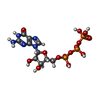 ChemComp-GTP: |
-Experimental details
-Structure determination
| Method | cryo EM |
|---|---|
 Processing Processing | single particle reconstruction |
| Aggregation state | particle |
- Sample preparation
Sample preparation
| Concentration | 1.5 mg/mL | ||||||||||||||||||
|---|---|---|---|---|---|---|---|---|---|---|---|---|---|---|---|---|---|---|---|
| Buffer | pH: 7.4 Component:
Details: 1x PBS (pH 7.4), 300mM NaCl, 1mM TCEP | ||||||||||||||||||
| Grid | Model: Quantifoil R1.2/1.3 / Material: COPPER / Mesh: 300 / Support film - Material: CARBON / Support film - topology: HOLEY / Pretreatment - Type: PLASMA CLEANING / Pretreatment - Time: 40 sec. / Pretreatment - Atmosphere: AIR Details: Used Quantifoil Active grids - backside gold coated before plasma cleaning. 12 mA used for plasma cleaning. | ||||||||||||||||||
| Vitrification | Cryogen name: ETHANE / Chamber humidity: 100 % / Chamber temperature: 296 K / Instrument: SPOTITON / Details: Commercialized version - chameleon. | ||||||||||||||||||
| Details | Specimen appeared as a monodisperse peak via size exclusion chromatography (SEC) |
- Electron microscopy
Electron microscopy
| Microscope | FEI TITAN KRIOS |
|---|---|
| Specialist optics | Energy filter - Name: TFS Selectris / Energy filter - Slit width: 20 eV |
| Image recording | Film or detector model: FEI FALCON IV (4k x 4k) / Average electron dose: 53.4 e/Å2 Details: 2 datasets collected, processed independently, and merged. |
| Electron beam | Acceleration voltage: 300 kV / Electron source:  FIELD EMISSION GUN FIELD EMISSION GUN |
| Electron optics | Illumination mode: FLOOD BEAM / Imaging mode: BRIGHT FIELD / Cs: 2.7 mm / Nominal defocus max: 1.4000000000000001 µm / Nominal defocus min: 0.4 µm / Nominal magnification: 81000 |
| Sample stage | Specimen holder model: FEI TITAN KRIOS AUTOGRID HOLDER / Cooling holder cryogen: NITROGEN |
| Experimental equipment |  Model: Titan Krios / Image courtesy: FEI Company |
+ Image processing
Image processing
-Atomic model buiding 1
| Initial model | Chain - Source name: AlphaFold / Chain - Initial model type: in silico model |
|---|---|
| Refinement | Space: REAL / Protocol: RIGID BODY FIT |
| Output model |  PDB-9c5b: |
 Movie
Movie Controller
Controller





















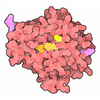

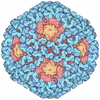


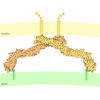






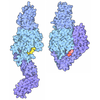



 Z (Sec.)
Z (Sec.) Y (Row.)
Y (Row.) X (Col.)
X (Col.)












































